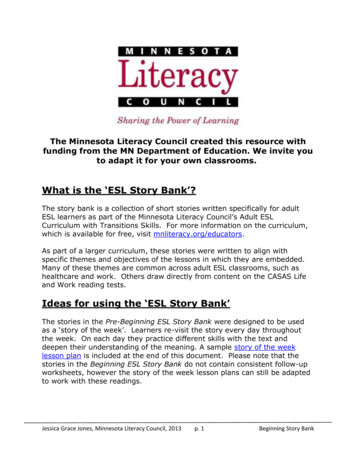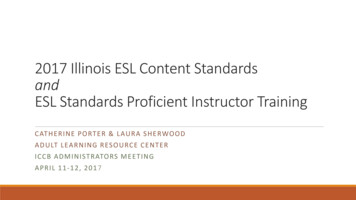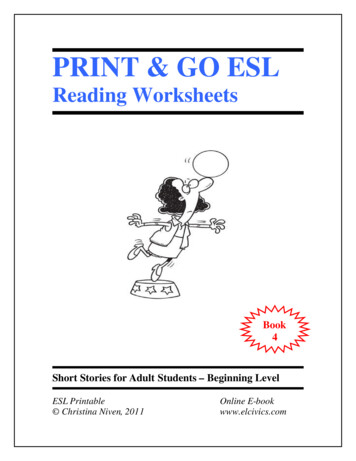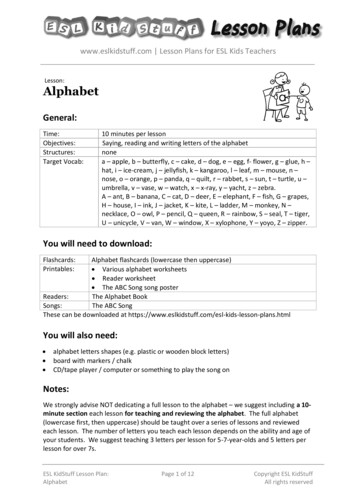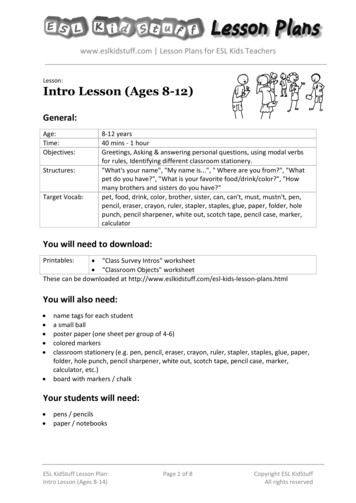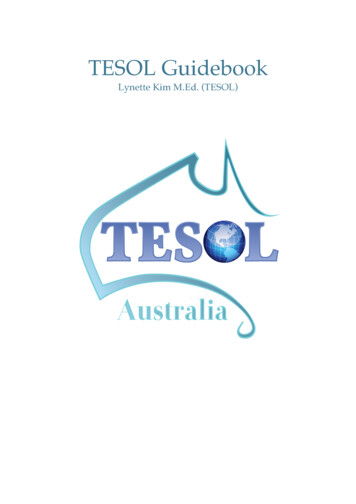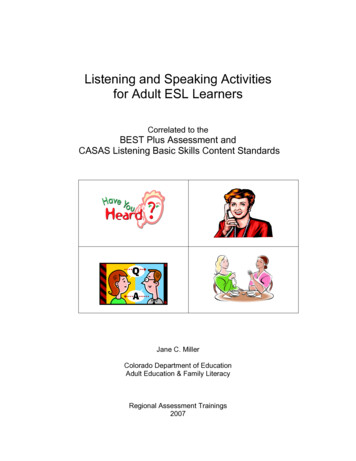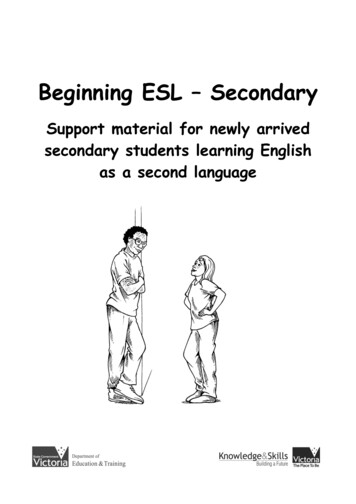
Transcription
Beginning ESL – SecondarySupport material for newly arrivedsecondary students learning Englishas a second language
AcknowledgmentsWritersPeter Macer, Pat NicholsonOther contributorsThe ESL Strategy Team, Department of Education &Training, VictoriaWe gratefully acknowledge use of the Victorian School Font Set. These fonts areavailable through www.schoolfonts.com.auPublished by Cultural and Linguistic Diversity Strategy UnitParticipation Initiatives BranchDepartment of Education & Training33 St Andrews Place, East Melbourne, 3002May 2004Also published on http://www.sofweb.vic.edu.au/lem/esl/index.htm Copyright State of Victoria 2004This publication is copyright. No part may be reproduced by any process except in accordance with the provisions of theCopyright Act 1968. Permission is hereby granted for purchasers to reproduce student material masters from the book inquantities suitable for teaching purposes and for non-commercial use.Authorised by the Victorian Government, 1 Treasury Place, East Melbourne 3002Printed by Corporate CopyingISBN/ISSN 0 7594 0381 3For further information about ESL teaching and learning materials and programs, BEGINNING ESL – SECONDARY: INTRODUCTIONDEPARTMENT OF EDUCATION & TRAINING VICTORIA, 2004PAGE 2
ContentsIntroduction . 4Purpose .4The units.4Functions and language features.5Supporting newly arrived students in secondary schools .6Communicating with parents .8Annotated bibliography .9Linking the teacher resources to the units . 16Unit 1 – Time . 17Introduction. 17Vocabulary . 17Functions . 17Grammatical features . 17Additional resources for the Time unit . 18Additional activities . 18Links with key learning areas . 19Worksheets . 19Unit 2 – Body and health . 31Introduction. 31Vocabulary . 31Functions . 31Grammatical features . 31Additional resources for the Body and Health unit . 32Additional activities . 32Links with key learning areas . 33Worksheets . 33Unit 3 – Personal identification . 48Introduction. 48Vocabulary . 48Functions . 48Grammatical features . 48Additional resources for the Personal identification unit . 49Additional activities . 49Worksheets . 50Unit 4 – The classroom . 68Introduction. 68Vocabulary . 68Functions . 68Grammatical features . 68Additional resources for the Classroom unit. 69Additional activities/Links with key learning areas . 69Worksheets . 69BEGINNING ESL – SECONDARY: INTRODUCTIONDEPARTMENT OF EDUCATION & TRAINING VICTORIA, 2004PAGE 3
IntroductionPurposeThe purpose of this publication is to provide support material for the teachers ofnewly arrived secondary English as a second language (ESL) learners. The materialis intended to be used with ESL students who: have little English (are within Stage S1 of the ESL Companion to the EnglishCurriculum and Standards Framework) have arrived in Australia with literacy and schooling in their first languagebroadly equivalent to the stage of schooling they are entering in Australia.This material is not designed for use with students who have low literacy skills intheir first language, although some of it may become suitable as students begin todevelop skills in reading and writing English.This material will be useful for: teachers in mainstream classes who may be unfamiliar with the needs of ESLlearners new to learning English ESL teachers literacy co-ordinators who may be given responsibility for assisting newlyarrived students in schools.The worksheets are designed to be used with extensive oral work and discussion.The unitsThe units included in this resource are:Unit 1TimeUnit 2Personal identificationUnit 3Body and healthUnit 4The classroom.The units includes tasks and content that are particularly suitable for newly arrivedESL learners. This material will help to familiarise students with the basic Englishthat will help them operate in the classroom, and will enable them to communicatesimple needs and wants in English.The sections in the book are referred to as units, but they are not designed ascomplete units of work. The material is not intended to provide a full ESL learningprogram for students but to provide teachers with resources that support oralEnglish language work. The worksheets are designed to consolidate language thathas already been taught in class and practised orally by the student, and to provideadditional reading and writing tasks.Teachers need to decide which units are most appropriate for individual students,and which make the most appropriate links to work that is currently being coveredin the key learning areas. Within each unit, the worksheets are generally sequential,and are organised according to the difficulty of the language.Each unit is accompanied by an outline of the structures, functions and vocabularywhich are covered by the worksheets, or are applicable for each unit of work. Italso provides additional ideas for teaching students the content of the unit.BEGINNING ESL – SECONDARY: INTRODUCTIONDEPARTMENT OF EDUCATION & TRAINING VICTORIA, 2004PAGE 4
Each unit also provides: learning outcomes likely from the topic a list of functions a list of language structures a vocabulary list references to other resources and materials that provide additional activities orinformation about the topic worksheets that can be photocopied or adapted for use, and information abouthow to use themFunctions and language featuresIn designing the worksheets, care has been taken to ensure that the functions whichare being taught are ones that are useful for a newly arrived student in a range ofcontexts. For example these students need to know how to give personalinformation, and how to ask for and tell the time, and the like. In the classroom, inparticular, there are often many ways of expressing the same meaning, which willvary according to the formality of the situation, the people involved and what isbeing talked about. For example, asking for assistance is likely to vary when astudent is talking to a teacher or to a fellow student. It will take some time forstudents to be able to respond to context in this way, in English, and teachers assistthis process by talking simply about the appropriateness of different functionallanguage to different situations. Teachers will also need to decide which functionsare most relevant for their particular students and which language features are mostappropriate for teaching these particular functions to the students.While an interest-based or topic-based theme is a useful way of organising Englishlanguage learning for newly arrived ESL learners, these are not the only ways oforganising units of work. It is also advisable, at times, to organise some teachingthat focuses on specific linguistic structures and features. A suggested list of thesefollows: Pronouns: e.g. you, I, me, him, her, them Possessive pronouns: e.g. my, your, his, hers, theirs Prepositions: e.g. in, next to, on, near, behind, between, in front of, around,above Demonstratives: e.g. this/that, these/those Adverbs of frequency: e.g. often, never, always, sometimes Quantifiers: e.g. some, many, all, none, no, a few Sequence words: e.g. first, next, before, after Conjunctions: e.g. and, but Modals: e.g. can, will, might, must, never.BEGINNING ESL – SECONDARY: INTRODUCTIONDEPARTMENT OF EDUCATION & TRAINING VICTORIA, 2004PAGE 5
Particular topics may lend themselves especially well to teaching some of theabove, and it is useful to extend units into these areas once the basic vocabulary hasbeen learnt, as in the following suggestions: ‘Time’ and adverbs of frequency, for example: I always eat breakfast in themorning. I sometimes go shopping with my friends. ‘Classroom and school’ and prepositions, for example: The teacher is next tothe whiteboard. The cassette player is on top of the desk. The chalk is under theblackboard. ‘Body and health’ and possessive adjectives, for example: my leg, her arm,your hair. ‘Safety’ and modals and imperatives, for example: you must walk on thepath, you should stay still.Supporting newly arrived students in secondary schoolsIt is recommended that, for at least the first six months, one teacher shouldhave primary responsibility for the newly arrived student. In schools wherethere is an ESL teacher, he or she will probably be responsible for the newstudent. In schools where there is not an ESL teacher the responsibility for thenewly arrived student may belong to the literacy co-ordinator, year levelco-ordinator, or another appointed teacher.Student background informationIt is particularly important to find out how much schooling newly arrivedstudents have had in their country of origin, and to try to find out their level ofliteracy in their first language. The student’s level of literacy in his/her firstlanguage will have an influence on language and literacy learning in English. Itis also important to find out if the student has learnt any English prior toenrolling in your school.It is also valuable to talk to parents and guardians about which language thestudent will be using as the main language at home. Encourage parents andguardians to continue to use their first language as well as English with theirchild. Explain that it is important for their child’s conceptual and socialdevelopment to continue to extend their first language, with English as anaddition to the first language, not a replacement for it.In eliciting background information about new students, it is important to besensitive. Some families may have experienced trauma and may not feelcomfortable about sharing information with strangers. Information may need tobe built up over time, and it can be useful to schedule a further interview withparents after the initial enrolment interview.It may be necessary to arrange for an interpreter to help in the collection ofinformation which is needed by the school. Government schools in Victoria areable to access interpreting and translation services. Guidelines for the use ofthese services can be found . Avoid using other students tointerpret, except in an emergency, or for the transmission of basic informationsuch as classroom instructions.BEGINNING ESL – SECONDARY: INTRODUCTIONDEPARTMENT OF EDUCATION & TRAINING VICTORIA, 2004PAGE 6
Catering for refugee students, and students who have had traumatic experiencesStudents who are refugees may have additional needs, particularly when theyare first settling in. They and their families may have experienced trauma; theymay be unsure about the fate of family members and friends; they may havefew resources; and students may have had interrupted schooling. Particularunderstanding is needed in these circumstances, for example students may takelonger to settle in, to begin to learn English, and to make friends.It is important for teachers to be particularly sensitive in gathering informationabout the past experiences of refugee students, but also to explain to parentsand guardians that such experiences may affect their child’s overall happinessand feelings of security and self-esteem. Explain that the school can assistfamilies if they need help with these issues. Contact the Victorian Foundationfor the Survivors of Torture Inc for assistance and information: PO Box 96,Parkville, Victoria 3052, Australia, Telephone 03 9388 0022 Fax 03 9387 0828http://www.survivorsvic.org.au.Settling inNewly arrived students in secondary schools will need particular help inunderstanding the way their school day is organised. Secondary school studentswill see a number of teachers and be required to change classrooms during theday. This can be disorientating for a newly arrived student who may not beused to changing teachers and classrooms. The diversity of teaching stylesstudents encounter may also be difficult for students to come to terms with.These difficulties will be exacerbated if a student arrives in the middle of theschool year when the other students have settled in, and are acquainted with theteaching styles and requirements of their different teachers. Make sure thatstudents are well supported during their first few weeks in the school, perhapsby other students or teacher aides, and make sure they have opportunities to askquestions and clarify anything that is confusing.Subject teachers may need assistance in understanding the needs of a newlyarrived student, if they are not used to teaching new ESL students. Teachersmay need to consider that, while new students may not initially be able tocommunicate in English to the same level as their English speaking peers,many have schooling equivalent to their peers. This means that they mayunderstand the content being covered in the different subject areas, and mayhave already mastered key concepts in their first language. Teachers will needsupport in developing work that the student can attempt in the classroom, andwhich assists the student to learn the English to enable them to talk about theunderstandings they already have. Other students may not have equivalentschooling to their peers (or the curriculum content may be different to that inAustralia) and will need assistance in both learning key concepts, and in theirEnglish language development. All teachers teaching the new arrival may needto use additional strategies in the classroom, such as more extensive use ofgraphics or diagrams, or helping students to develop topic dictionaries.BEGINNING ESL – SECONDARY: INTRODUCTIONDEPARTMENT OF EDUCATION & TRAINING VICTORIA, 2004PAGE 7
Some important considerations for the first weeks Find out the correct way to pronounce your new student’s name andcommunicate this to the staff who will be dealing with him/her. It is important to place newly arrived students in an age-appropriate class,and to not place them in a lower class or with students with learningdifficulties. If possible try to find other students in the school who speak the samelanguage and who are willing to help the newly arrived student to settle in.This task can be shared among a number of students, as the newly arrivedstudent will need this kind of assistance for some time. Ensure that the student has access to a bilingual dictionary. Provide visual and non-verbal support wherever possible, for examplefacial expressions, mime and gestures to support instructions.For other strategies for assisting students to settle into their new school, see NoEnglish Don’t Panic (Department of Education, Employment, and Training,Victoria, 2000) and No English 2 – Questions and answers (Department ofEducation, Employment, and Training, Victoria, 2000).Giving feedbackIt is important that students receive feedback on their progress from theirteachers. This is sometimes more difficult in secondary schools where studentschange classes and teachers throughout the day and where teachers may onlysee some students once or twice a week. Teachers may need to develop someadditional strategies to ensure that the newly arrived student’s progress isclosely monitored and any difficulties experienced by the student are quicklyidentified.Communicating with parentsGuidelines for accessing interpreting and translation services for Victoriangovernment schools can be found To support communication between the school and families from languagebackgrounds other than English, 22 school notices commonly requested fortranslation are available in 20 languages, including English. This is a veryuseful resource when communicating with parents, and contains translatedinformation and permission forms for excursions, camps, swimming classes,parent-teacher interviews and so on. The files are in PDF format. This resourceand a list of other materials that have already been translated for parents areavailable at: INNING ESL – SECONDARY: INTRODUCTIONDEPARTMENT OF EDUCATION & TRAINING VICTORIA, 2004PAGE 8
The Languages and Multicultural Education Resources Centre(LMERC)LMERC is a specialist support centre for Victorian schools in the areas oflanguages other than English, ESL and multicultural education. Victorianteachers may borrow a wide range of print, audio, video, and CD-ROMresources.The LMERC lending library has a collection of over 20,000 resources whichincludes: teacher reference materials for LOTE, ESL and multicultural education culturally inclusive picture books, fiction and big books, and posters selected journals related to language teaching and multicultural education pamphlets, clippings and articles videos, CD-ROMs, DVDs and audio cassettes (English and multilingual) resource materials on human rights education, civics and citizenship,prejudice, racism and social justice studies of Asia resources units of work, teacher's notes and Ideas Bank LOTE, ESL and multicultural education policy documents.The LMERC catalogue is now available on-line mAnnotated bibliographyVictorian Curriculum and Assessment Authority (VCAA) publicationsESL Companion to the English Curriculum and Standards Framework, 2000For students learning English as a second language, not as a first language, theoutcomes in the English CSF are unlikely to be appropriate descriptions of theirlearning. The ESL Companion will be more appropriate as it providesdescriptions of broad stages of ESL development. It provides learning outcomesfor ESL students, which can assist with assessment and program planning. It isorganised in strands and modes that correlate to the strands and modes of theEnglish CSF, and includes a curriculum focus for each strand at each stage. TheESL Companion is published by the Victorian Curriculum and AssessmentAuthority. The following sections in particular should be referred to: the introduction for general information about the ESL learning area Stage S1 if the student is in Years 7–10 Stage SL if the student is in Years 7–10, but is not literate in the firstlanguage, or has had severely interrupted schooling.As students learn more English, the learning outcomes of Stage S2 will becomeincreasingly appropriate to them. Read this stage so that you will have someidea of the kind of development to expect from your student.The ESL Companion to the English CSF II is accessible on-line to Victorianteachers at x.htm. It isalso available from the Victorian Curriculum and Assessment Authority athttp://csf.vcaa.vic.edu.au/home.htm. It can be purchased from InformationVictoria, 356 Collins Street, Melbourne, 3000. Tel: 1300 366 356 (Local callcost.) Fax: 9603 9920. Website: http://www.information.vic.gov.auBEGINNING ESL – SECONDARY: INTRODUCTIONDEPARTMENT OF EDUCATION & TRAINING VICTORIA, 2004PAGE 9
Department of Education & Training publicationsTeacher Support Material Stages S1 and S2: Secondary new arrivalsYears 7–10 (2000)This material, on curriculum@work CD-ROM, covers Stages S1 and S2 of theESL Companion and includes a revised version of previously published ESLCourse Advice. It provides information to assist mainstream teachers and ESLspecialists to develop and provide appropriate curriculum for their newlyarrived ESL beginners. It also contains units of work including units thatintroduce ESL students to new technologies. curriculum@work can beaccessed on-line at x.htmThe curriculum@work CD-ROM is available from: Information Victoria,356 Collins Street, Melbourne 3000, Tel: 1300 366 356 (Local call cost.) Fax:9603 9920. Website: http://www.information.vic.gov.au/index.htmlNo English – Don’t Panic (2000)This publication provides information and strategies for primary classroomteachers of newly arrived ESL students in their first few weeks in Australia, butmuch of the material is also very useful for teachers of secondary new arrivals,particularly those in Years 7 and 8. It provides information about enrolmentand placement, helping students settle into their new school, and providing forearly English language learning needs.For information about purchasing this publication No English 2 – Questions and answers (2000)No English 2 – Questions and Answers is a follow-on book from No English –Don’t Panic. It provides answers to some of the questions primary classroomteachers may have about the English language development of newly arrivedESL learners, and about providing appropriate programs for them. Much of theinformation is also applicable to newly-arrived students in the early years ofsecondary education.For information about purchasing this publication Beginning ESL – Support material for primary new arrivals (1998)Supports primary mainstream classroom teachers by providing practical ideasand resources for newly arrived ESL learners. The material is organised intosixteen units of work, based around topics that are appropriate for newlyarrived students. The activities and worksheets are designed to encouragecommunication and interaction between the new student, the teacher and otherstudents in the class. Although the material is aimed at primary students, muchof it is also appropriate for secondary students, particularly those in the earlyyears of secondary school. Each unit contains: learning outcomes for the topic and for English learning lists of vocabulary and grammar features worksheets which may be photocopied additional references and lists of resources.For information about purchasing this publication BEGINNING ESL – SECONDARY: INTRODUCTIONDEPARTMENT OF EDUCATION & TRAINING VICTORIA, 2004PAGE 10
First Language Assessment Tasks (2000)First Language Assessment Tasks helps to assess students’ reading and writingskills in the languages of Arabic, Khmer, Somali or Vietnamese. It comprisessets of photocopiable assessment tasks and recording sheets. The tasks weredesigned for newly arrived students entering Australian schools at the upperprimary and secondary levels. It is envisaged that the tasks will be most usefulwith students who have had little or no schooling in their first language. Forinformation about purchasing this publication Language games for ESL students (2004)These photocopiable materials can be used to make language games for ESL)students, across all year levels. The games consolidate and reinforce skills inspeaking, listening, reading and writing, and give students a chance to use arange of language functions important for working and playing with others.Many suggestions on how to play a range of games are provided. The gamesare based on 19 topics that are usually taught to newly arrived ESL students.For information about purchasing this publication Where’s English? (2001)Where’s English? is a multimedia resource to develop the English languageskills of students at the beginning stages of learning English as a secondlanguage. It has been designed around the animated story of a 14-year old girl,Anna, who has lost her pet blue-tongue lizard, named ‘English’. The lizardleads Anna and her friend Lee on a search that takes place in the town ofBayside, where they interact with family members, school friends and adultsliving and working in the town. It is presented in 24 episodes, and each episodeprovides the basis for a range of English language activities that students cancomplete on the CD-ROMs. Students also work with 24 student workbooksthat complement each of the episodes on the CD-ROMs. Apart from theintroduction and conclusion, all episodes are self-contained with no prescribedpathways through them, and students can access the episodes in any order.Where’s English? has been developed primarily to support newly arrived ESLstudents in the middle years of schooling.For information about purchasing this publication BEGINNING ESL – SECONDARY: INTRODUCTIONDEPARTMENT OF EDUCATION & TRAINING VICTORIA, 2004PAGE 11
Other resourcesAdelson-Goldstein, J. The Basic Oxford Picture Dictionary (Workbook),OUP, New York, 1994.A workbook which provides reading and writing activities for beginning level,young adult ESL students. Each page in the workbook corresponds to a specificpage in the Basic Oxford Picture Dictionary. Activities include categorising,labelling matching, and puzzle solvi
newly arrived secondary English as a second language (ESL) learners. The material is intended to be used with ESL students who: have little English (are within Stage S1 of the ESL Companion to the English Curriculum and Standards Framework) have arrived in Australia with literacy and schooling in their first language


